
Forensic science, also known as criminalistics, is the application of science principles and methods to support legal decision-making in matters of criminal and civil law.

Forensic anthropology is the application of the anatomical science of anthropology and its various subfields, including forensic archaeology and forensic taphonomy, in a legal setting. A forensic anthropologist can assist in the identification of deceased individuals whose remains are decomposed, burned, mutilated or otherwise unrecognizable, as might happen in a plane crash. Forensic anthropologists are also instrumental in the investigation and documentation of genocide and mass graves. Along with forensic pathologists, forensic dentists, and homicide investigators, forensic anthropologists commonly testify in court as expert witnesses. Using physical markers present on a skeleton, a forensic anthropologist can potentially determine a person's age, sex, stature, and race. In addition to identifying physical characteristics of the individual, forensic anthropologists can use skeletal abnormalities to potentially determine cause of death, past trauma such as broken bones or medical procedures, as well as diseases such as bone cancer.
Electronic Facial Identification Technique is a computer-based method of producing facial composites of wanted criminal(s), based on eyewitness descriptions.

A crime scene is any location that may be associated with a committed crime. Crime scenes contain physical evidence that is pertinent to a criminal investigation. This evidence is collected by crime scene investigators (CSI) and law enforcement. The location of a crime scene can be the place where the crime took place or can be any area that contains evidence from the crime itself. Scenes are not only limited to a location, but can be any person, place, or object associated with the criminal behaviours that occurred.

Forensic facial reconstruction is the process of recreating the face of an individual from their skeletal remains through an amalgamation of artistry, anthropology, osteology, and anatomy. It is easily the most subjective—as well as one of the most controversial—techniques in the field of forensic anthropology. Despite this controversy, facial reconstruction has proved successful frequently enough that research and methodological developments continue to be advanced.
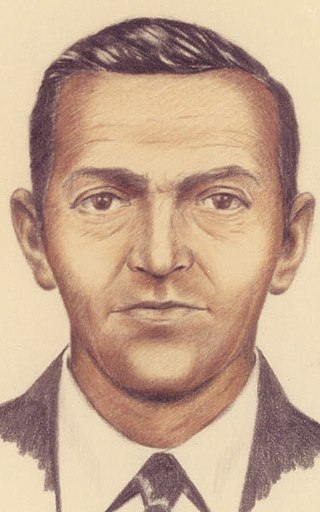
A facial composite is a graphical representation of one or more eyewitnesses' memories of a face, as recorded by a composite artist. Facial composites are used mainly by police in their investigation of crimes. These images are used to reconstruct the suspect's face in hope of identifying them. Facial reconstruction can also be used in archeological studies to get a visualization of ancient mummies or human remains.
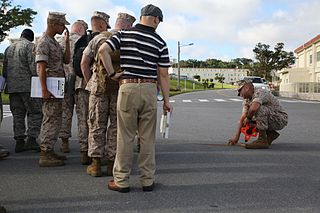
Traffic collision reconstruction is the process of investigating, analyzing, and drawing conclusions about the causes and events during a vehicle collision. Reconstructionists conduct collision analysis and reconstruction to identify the cause of a collision and contributing factors including the role of the driver(s), vehicle(s), roadway and general environment. Physics and engineering principles are the basis for these analyses and may involve the use of software for calculations and simulations. Collision reconstruction is sometimes used as the basis of expert witness testimony at trials. Collision reconstructions are performed in cases involving fatalities or personal injury. Results from collision reconstructions are also sometimes used for making roads and highways safer, as well as improving safety aspects of motor vehicle designs. Reconstructions are typically conducted by forensic engineers, specialized units in law enforcement agencies, or private consultants.
The following outline is provided as an overview of and topical guide to forensic science:

Harvey Phillip Pratt is an American forensic artist and Native American artist, who has worked for over forty years in law enforcement, completing thousands of composite drawings and hundreds of soft tissue postmortem reconstructions. To this end, his work has assisted in thousands of arrests and hundreds of identification of unidentified human remains throughout America. His expertise in witness description drawing, skull reconstruction, skull tracing, age progression, soft tissue postmortem drawing and restoration of photographs and videos have aided law enforcement agencies both nationally and internationally. Pratt also assists investigations through training classes, besides lecturing before universities, colleges, schools and civic groups. In the early 2000s Pratt teamed up with David Paulides in researching Bigfoot on the Hoopa Reservation in California, as well as in his home state of Oklahoma.

Forensic footwear evidence can be used in legal proceedings to help prove that a shoe was at a crime scene. Footwear evidence is often the most abundant form of evidence at a crime scene and in some cases can prove to be as specific as a fingerprint. Initially investigators will look to identify the make and model of the shoe or trainer which made an impression. This can be done visually or by comparison with evidence in a database; both methods focus heavily on pattern recognition and brand or logo marks. Information about the footwear can be gained from the analysis of wear patterns which are dependent on angle of footfall and weight distribution. Detailed examination of footwear impressions can help to link a specific piece of footwear to a footwear imprint as each shoe will have unique characteristics.
Virtopsy is a virtual alternative to a traditional autopsy, conducted with scanning and imaging technology. The name is a portmanteau of "virtual" and "autopsy" and is a trademark registered to Richard Dirnhofer, the former head of the Institute of Forensic Medicine of the University of Bern, Switzerland.
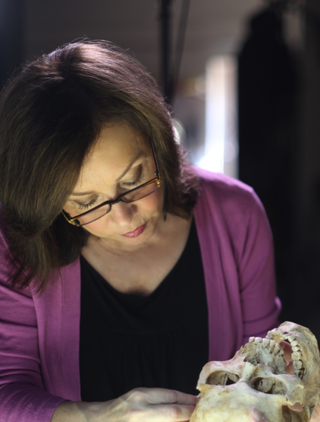
Karen T. Taylor is an American forensic and portrait artist who has worked to help resolve criminal cases for a variety of law enforcement agencies throughout the world. Her primary expertise includes composite imagery, child and adult age progression, postmortem drawing and forensic facial reconstruction. In the mid-1980s, Taylor pioneered the method of 2-dimensional facial reconstruction, by drawing facial features over frontal and lateral skull photographs based on anthropological data. Taylor is also well-established as a forensic art educator, fine art portrait sculptor, and specialist in the human face.
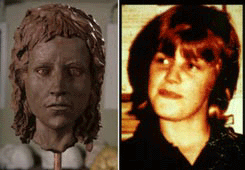
Karen Price was a 15-year-old Welsh murder victim who disappeared in 1981. After the discovery of her body in 1989, British facial reconstruction artist Richard Neave used her skull to create a model of her physical appearance. The reconstruction and the matching of DNA in the body to that of Price's parents allowed her body to be identified. The case was cited as one of the first instances in which DNA technology was used in this way.

Sherri Ann Jarvis was an American murder victim from Forest Lake, Minnesota whose body was discovered in Huntsville, Texas on November 1, 1980. Her body was discovered within hours of her sexual assault and murder, and remained unidentified for 41 years before investigators announced her identification via forensic genealogy in November 2021.
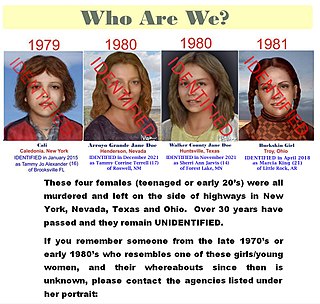
Unidentified decedent, or unidentified person, is a corpse of a person whose identity cannot be established by police and medical examiners. In many cases, it is several years before the identities of some UIDs are found, while in some cases, they are never identified. A UID may remain unidentified due to lack of evidence as well as absence of personal identification such as a driver's license. Where the remains have deteriorated or been mutilated to the point that the body is not easily recognized, a UID's face may be reconstructed to show what they had looked like before death. UIDs are often referred to by the placeholder names "John Doe" or "Jane Doe". In a database maintained by the Ontario Provincial Police, 371 unidentified decedents were found between 1964 and 2015.

DNA phenotyping is the process of predicting an organism's phenotype using only genetic information collected from genotyping or DNA sequencing. This term, also known as molecular photofitting, is primarily used to refer to the prediction of a person's physical appearance and/or biogeographic ancestry for forensic purposes.

Betty Patricia Gatliff was an American pioneer in the field of forensic art and forensic facial reconstruction. Working closely with forensic anthropologist Dr. Clyde Snow, she sculpturally reconstructed faces of individuals including the Pharaoh Tutankhamun, President John F. Kennedy, and the unidentified victims of serial killer John Wayne Gacy.
Identity replacement technology is any technology that is used to cover up all or parts of a person's identity, either in real life or virtually. This can include face masks, face authentication technology, and deepfakes on the Internet that spread fake editing of videos and images. Face replacement and identity masking are used by either criminals or law-abiding citizens. Identity replacement tech, when operated on by criminals, leads to heists or robbery activities. Law-abiding citizens utilize identity replacement technology to prevent government or various entities from tracking private information such as locations, social connections, and daily behaviors.
Mary Huffman Manhein is an American forensic anthropologist. Nicknamed The Bone Lady, she was the founding director of the Forensic Anthropology and Computer Enhancement Services (FACES) laboratory at Louisiana State University (LSU) in 1990, and of the Louisiana Repository for Unidentified and Missing Persons Information Program in 2006. The repository is considered the "most comprehensive statewide database of its kind".

Carl Koppelman is an American professional accountant and unpaid volunteer forensic sketch artist. Since 2009, Koppelman has drawn over 250 reconstructions and age progressions of missing and unidentified people.












